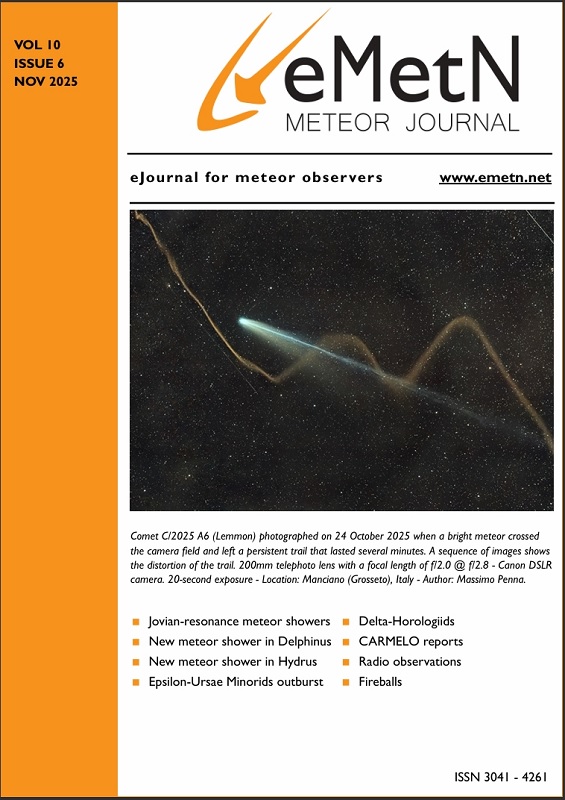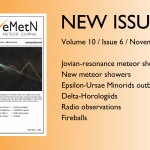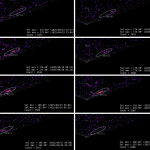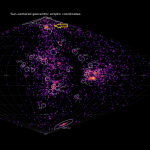Meteor season finally gets going in July for the northern hemisphere. The first half of the month will be much like June with predominantly slow rates. After the 15th though, both sporadic and shower rates increase significantly. For observers in the southern hemisphere, sporadic rates will be falling but the overall activity will increase with the arrival of the Southern delta Aquariids during the last week of the month.
During this period, the moon reaches its first quarter phase on Wednesday July 2nd. At that time the moon will be located 90 degrees east of the sun and will set near midnight July 2/3. This weekend the waxing crescent moon will set during the evening hours and will not be a hindrance to meteor observing during the more active morning hours. The estimated total hourly rates for evening observers this weekend should be near 3 as seen from mid-northern latitudes (45N) and 4 as seen from tropical southern locations (25S). For morning observers, the estimated total hourly rates should be near 10 as seen from mid-northern latitudes (45N) and 13 as seen from tropical southern locations (25S). The actual rates seen will also depend on factors such as personal light and motion perception, local weather conditions, alertness, and experience in watching meteor activity. Evening rates are slightly reduced due to moonlight. Note that the hourly rates listed below are estimates as viewed from dark sky sites away from urban light sources. Observers viewing from urban areas will see less activity as only the brighter meteors will be visible from such locations.
The radiant (the area of the sky where meteors appear to shoot from) positions and rates listed below are exact for Saturday night/Sunday morning June 28/29. These positions do not change greatly day to day so the listed positions may be used during this entire period. Most star atlases (available online and at bookstores and planetariums) will provide maps with grid lines of the celestial coordinates so that you may find out exactly where these positions are located in the sky. I have also included charts of the sky that display the radiant positions for evening, midnight, and morning. The center of each chart is the sky directly overhead at the appropriate hour. These charts are oriented for facing south but can be used for any direction by rotating the charts to the desired direction. A planisphere or computer planetarium program is also useful in showing the sky at any time of night on any date of the year. Activity from each radiant is best seen when it is positioned highest in the sky (culmination), either due north or south along the meridian, depending on your latitude. Radiants that rise after midnight will not reach their highest point in the sky until daylight. For these radiants, it is best to view them during the last few hours before dawn. It must be remembered that meteor activity is rarely seen at its radiant position. Rather they shoot outwards from the radiant, so it is best to center your field of view so that the radiant lies toward the edge and not the center. Viewing there will allow you to easily trace the path of each meteor back to the radiant (if it is a shower member) or in another direction if it is sporadic. Meteor activity is not seen from radiants that are located far below the horizon. The positions below are listed in a west to east manner in order of right ascension (celestial longitude). The positions listed first are located further west therefore are accessible earlier in the night while those listed further down the list rise later in the night.
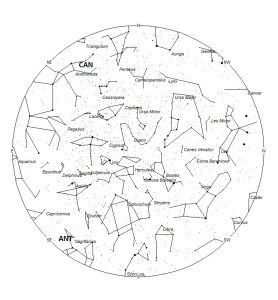
Radiant Positions at 23:00 LST
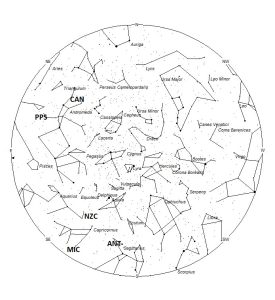
Radiant Positions at 01:00 LST
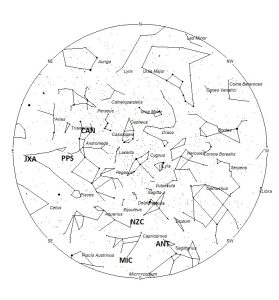
Radiant Positions at 03:00 LST
These sources of meteoric activity are expected to be active this week
.
The large Anthelion (ANT) radiant is currently centered at 19:20 (290) -22. This position lies in eastern Sagittarius, 2 degrees southeast of the 3rd magnitude star known as Albaldah (pi Sagittarii). This radiant is best placed near 02:00 Local Summer Time (LST) when it lies on the meridian and is highest in the southern sky. Rates at this time should be 1 per hour as seen from the northern hemisphere and 2 per hour as seen from south of the equator. With an entry velocity of 30 km/sec., the average Anthelion meteor would be of medium-slow velocity.
The Northern June Aquilids (NZC) has been known as a weak shower for nearly 100 years. Details on these meteors are quite variable, depending on the source. It is active for at least six weeks with maximum activity occurring around the 1st of July. The current radiant is thought to be active near 20:28 (307) -07. This area of the sky is located in southeastern Aquila, 5 degrees northeast of the 3rd magnitude star known as Algedi (alpha2 Capricornii). This area of the sky is best placed near 0300 LST when it lies highest above the southern horizon. Hourly rates at this time may be near 1 no matter your location. With an entry velocity of 40 km/sec., these meteors would be of medium velocity.
The Microscopiids (MIC) were discovered by G. Gartrell and W. G. Elford, in their study of Southern Hemisphere meteor streams. This stream is active from June 25 through July 16 with maximum activity occurring on July 3rd. The radiant is currently located at 20:49 (312) -28. This area of the sky is located in northern Microscopium, 1 degree south of the 4th magnitude star known as omega Capricornii. This radiant is best placed near 0300 LST, when it lies on the meridian and is located highest in the southern sky. Hourly rates at this time should be less than 1 no matter your location. With an entry velocity of 40 km/sec., the average meteor from this source would be of medium-slow velocity. This shower is synonymous with the Southern June Aquilids (SZC).
The phi Piscids (PPS) were discovered by Dr. Peter Brown using Canadian radar data (CMOR). This is a complex shower involving two streams that cannot be separated visual means. These meteors are active from June 21-July 28 with maximum activity occurring on June 30th. The current position of this radiant lies near 00:52 (013) +23, which places it in southern Andromeda, 1 degree west of the 4th magnitude star known as Kui (eta Andromedae). These meteors are best seen during the last hour prior to dawn when the radiant lies highest in the eastern sky while it is still dark. Current hourly rates are expected to be near 1 no matter your location. With an entry velocity of 67 km/sec., these meteors would have a swift velocity.
The c-Andromedids (CAN) were discovered by Sirko Molau and Juergen Rendtel using video data from the IMO network. Activity from this source is seen from June 21 through July 15 with maximum activity occurring on July 7. The radiant currently lies at 01:17 (019) +44, which places it in northern Andromeda, 5 degrees northeast of the Great Andromeda Galaxy, which is visible to the naked eye as a small oval cloud. This area of the sky is best seen during the last dark hour before dawn when the radiant lies highest in the northeastern sky. Observers in the northern hemisphere are better situated to view this activity as the radiant rises much higher in the sky before dawn compared to southern latitudes. Current rates would be less than 1 per hour no matter your location. With an entry velocity of 57 km/sec., the average meteor from this source would be of swift velocity.
The July chi Arietids (JXA) were discovered by two investigating teams in Europe using video data from European video Meteor Network Database (EDMOND), SonotaCo, 2013; and CMN, 2013. Activity from this stream is seen from June 26 through Aug 06 with maximum activity occurring on July 17th. The radiant currently lies at 01:41 (025) +04, which places it in southeastern Pisces, 1 degree south of the 4th magnitude star known as nu Piscium. This area of the sky is best seen during the last dark hour before dawn when the radiant lies highest in the eastern sky. Current rates are expected to be less than 1 no matter your location. With an entry velocity of 68 km/sec., the average meteor from this source would be of swift velocity.
Sporadic meteors are those meteors that cannot be associated with any known meteor shower. All meteor showers are evolving and disperse over time to the point where they are no longer recognizable. Away from the peaks of the major annual showers, these sporadic meteors make up the bulk of the activity seen each night. As seen from the mid-northern hemisphere (45N) one would expect to see during this period approximately 7 sporadic meteors per hour during the last hour before dawn as seen from rural observing sites. Evening rates would be near 1 per hour. As seen from the tropical southern latitudes (25S), morning rates would be near 9 per hour as seen from rural observing sites and 2 per hour during the evening hours. Locations between these two extremes would see activity between these listed figures. Evening rates are slightly reduced due to moonlight.
The list below offers information in tabular form of the active showers that I feel are within reach of the visual observer to discern. Hourly rates are often less than one, so these sources are rarely listed as visual targets in most meteor shower lists. If you are like me and wish to associate as many meteors as possible with known sources, then you will appreciate these listings. Before claiming to have seen meteors from these class IV showers, you should attempt to determine if these meteors actually belong to them and are not chance alignments of sporadic meteors. You can note parameters such as duration, length, radiant distance and the elevation of each meteor to help compute the probability of shower association. It should be remembered that slow meteors can be seen from fast showers, but fast meteors cannot be produced from slow showers. Slower showers are those with velocities less than 35/km per second. Slow meteors can appear from fast showers when they appear close to the radiant or low in the sky. The table located on page 22 of the IMO’s 2025 Meteor Shower Calendar is a big help in aiding in the identification of meteors. If you record the length and duration of each meteor, you can use this chart to check the probability of the meteor belonging to a shower of known velocity. If the angular velocity is similar to the figure in the table, then your meteor probably belongs to that shower. Recognizing meteors from obscure showers is certainly not for the beginning meteor observer as it takes many hours to get a feel of what you are seeing. It is our hope that you will advance beyond watching meteors as a fireworks display and will want to help us expand our knowledge of the heavenly bodies we encounter in the skies above by classifying each meteor you see. Rates and positions in the table are exact for Saturday night/Sunday morning.
| SHOWER | DATE OF MAXIMUM ACTIVITY | CELESTIAL POSITION | ENTRY VELOCITY | CULMINATION | HOURLY RATE | CLASS |
| RA (RA in Deg.) DEC | Km/Sec | Local Summer Time | North-South | |||
| Anthelion (ANT) | – | 19:20 (290) -22 | 30 | 02:00 | 1 -2 | II |
| Northern June Aquilids (NZC) | Jul 03 | 20:28 (307) -07 | 40 | 03:00 | 1 – 1 | IV |
| Microscopiids (MIC) | Jul 03 | 20:49 (312) -28 | 40 | 03:00 | <1 – <1 | IV |
| phi Piscids (PPS) | Jun 30 | 00:52 (013) +23 | 67 | 09:00 | 1 – 1 | IV |
| c-Andromedids (CAN) | Jul 07 | 01:17 (019) +44 | 57 | 09:00 | <1 – <1 | IV |
| July chi Arietids (JXA) | Jul 17 | 01:41 (025) +04 | 68 | 10:00 | <1 – <1 | IV |
You can keep track of the activity of these meteor showers as well as those beyond the limits of visual observing by visiting the NASA Meteor Shower Portal. You can move the sky globe to see different areas of the sky. Colored dots indicate shower meteors while white dots indicate sporadic (random) activity. The large orange disk indicates the position of the sun so little activity will be seen in that area of the sky.
Class Explanation: A scale to group meteor showers by their intensity:
- Class I: the strongest annual showers with Zenith Hourly Rates normally ten or better.
- Class II: reliable minor showers with ZHR’s normally two to ten.
- Class III: showers that do not provide annual activity. These showers are rarely active yet have the potential to produce a major display on occasion.
- Class IV: weak minor showers with ZHR’s rarely exceeding two. The study of these showers is best left to experienced observers who use plotting and angular velocity estimates to determine shower association. These weak showers are also good targets for video and photographic work. Observers with less experience are urged to limit their shower associations to showers with a rating of I to III.

